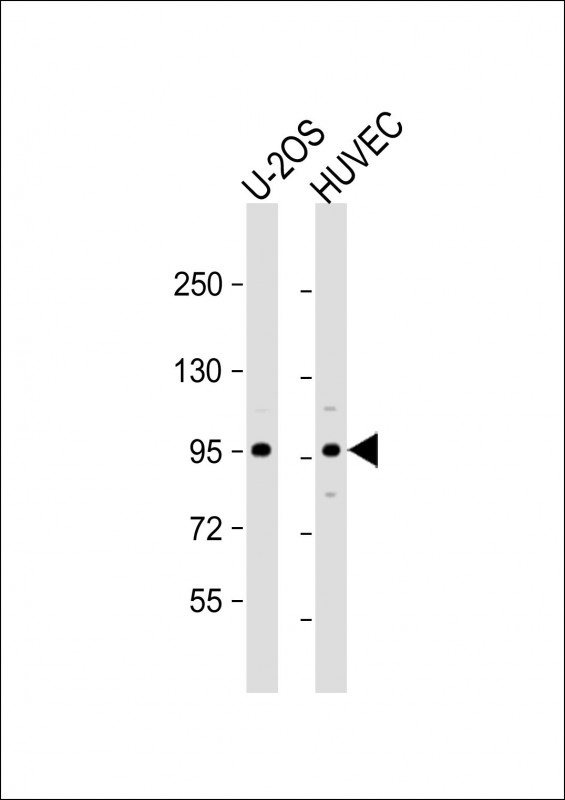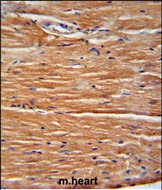

| WB | 1/2000 | Human,Mouse,Rat |
| IF | 咨询技术 | Human,Mouse,Rat |
| IHC | 1/100-1/500 | Human,Mouse,Rat |
| ICC | 技术咨询 | Human,Mouse,Rat |
| FCM | 咨询技术 | Human,Mouse,Rat |
| Elisa | 咨询技术 | Human,Mouse,Rat |
| Aliases | ARF GTPase-activating protein GIT1, ARF GAP GIT1, Cool-associated and tyrosine-phosphorylated protein 1, CAT-1, CAT1, G protein-coupled receptor kinase-interactor 1, GRK-interacting protein 1, GIT1 |
| Entrez GeneID | 28964 |
| WB Predicted band size | 84.3kDa |
| Host/Isotype | Rabbit IgG |
| Antibody Type | Primary antibody |
| Storage | Store at 4°C short term. Aliquot and store at -20°C long term. Avoid freeze/thaw cycles. |
| Species Reactivity | Human |
| Immunogen | This GIT1 antibody is generated from rabbits immunized with a KLH conjugated synthetic peptide between 485-512 amino acids from the Central region of human GIT1. |
| Formulation | Purified antibody in PBS with 0.05% sodium azide,1%BSA and 50% glycerol.prepared by Saturated Ammonium Sulfate (SAS) . |
+ +
以下是关于GIT1抗体的3篇参考文献及其摘要概括:
---
1. **"GIT1 is involved in dendritic spine morphogenesis and interacts with actin regulatory proteins"**
- **作者**: Manabe H, et al.
- **摘要**: 本研究通过免疫组化和Western blot技术,利用GIT1抗体探究了GIT1蛋白在神经元树突棘形态发生中的作用。结果显示,GIT1通过与肌动蛋白调控蛋白(如PAK和PIX)相互作用,调节突触结构的动态变化。
2. **"The GIT family of proteins forms multimers and associates with the presynaptic cytomatrix protein Piccolo"**
- **作者**: Premont RT, et al.
- **摘要**: 文章报道了GIT1在突触前终末的功能,通过GIT1抗体检测发现其与突触细胞骨架蛋白Piccolo的结合,并揭示了GIT家族蛋白通过形成多聚体参与突触囊泡的运输和神经递质释放调控。
3. **"The role of GIT1 in vascular remodeling and angiogenesis"**
- **作者**: Hoefen RJ, et al.
- **摘要**: 利用GIT1抗体进行体内外实验,研究发现GIT1通过调控内皮细胞迁移和血管生成相关信号通路(如MAPK/ERK),在血管重塑中发挥关键作用,为心血管疾病治疗提供了潜在靶点。
---
以上文献均通过GIT1抗体进行蛋白定位、表达分析或功能研究,涵盖神经生物学、细胞迁移及血管生成等领域。如需具体期刊信息或发表年份,可进一步补充检索。
The GIT1 (G protein-coupled receptor kinase-interacting protein 1) antibody is a tool used to detect and study the GIT1 protein, a multifunctional scaffolding protein involved in diverse cellular processes. GIT1 belongs to the GIT protein family, which includes two members (GIT1 and GIT2) sharing conserved domains like ARF-GAP and coiled-coil regions. It interacts with various signaling molecules, including G protein-coupled receptor kinases (GRKs), Rho-family GTPases, and the PAK-PIX-GIT complex, regulating cell adhesion, migration, and synaptic plasticity.
GIT1 localizes to focal adhesions and synapses, where it modulates cytoskeletal dynamics and vesicular trafficking. It acts as a GTPase-activating protein (GAP) for ARF GTPases and regulates RhoA activity, influencing actin reorganization. In neurons, GIT1 participates in synapse formation, dendritic spine morphogenesis, and neurotransmitter receptor clustering by interacting with postsynaptic density proteins like PSD-95.
Antibodies against GIT1 are widely used in Western blotting, immunofluorescence, and immunoprecipitation to investigate its expression, subcellular distribution, and molecular interactions. Research highlights its roles in neurological disorders (e.g., Alzheimer’s disease, Huntington’s disease), cancer metastasis, and cardiovascular diseases. Dysregulation of GIT1 is linked to abnormal cell motility in cancers (e.g., breast, lung) and impaired synaptic function in neurodevelopmental disorders. These antibodies are critical for exploring GIT1’s mechanistic contributions to disease models and potential therapeutic targets.
×